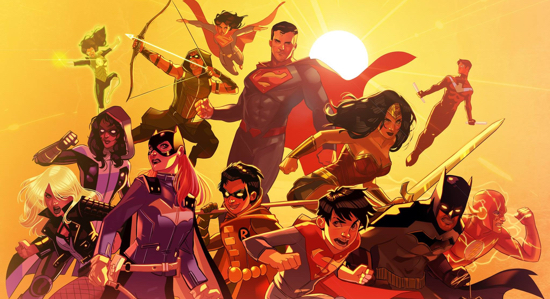Joe Corallo: Rebirth Revisited
DC’s Rebirth is now in full swing. Last week I wrote a response to one aspect of DC Rebirth #1. Later that week, I picked up Batman, Superman, and Green Arrow Rebirth (sorry Green Lanterns Rebirth). I read them. They ranged from awkward to interesting with Green Arrow, to me, being the most solid of those three. There was something not sitting right with me as I read these issues though, and it wasn’t in regards to the story or the art in the comics but in the credits and advertising.
 Every one of those comics, including Green Lanterns Rebirth which I haven’t picked up yet, features exclusively male creators. Every. Single. One. In the middle of the books themselves they all advertise four more upcoming comics for Rebirth: Action Comics, New Super-Man, Superwoman, and Supergirl. All of which are exclusively male creator teams. Finally, in the back of each issue they advertise for more Rebirth comics including Flash, Wonder Woman, Aquaman, and Titans. All of which, again, are exclusively male creator teams. That is a total of twelve ongoings as well as the DC Rebirth one-shot with not one female creator. Not one.
Every one of those comics, including Green Lanterns Rebirth which I haven’t picked up yet, features exclusively male creators. Every. Single. One. In the middle of the books themselves they all advertise four more upcoming comics for Rebirth: Action Comics, New Super-Man, Superwoman, and Supergirl. All of which are exclusively male creator teams. Finally, in the back of each issue they advertise for more Rebirth comics including Flash, Wonder Woman, Aquaman, and Titans. All of which, again, are exclusively male creator teams. That is a total of twelve ongoings as well as the DC Rebirth one-shot with not one female creator. Not one.
That’s not to say that they won’t be having women on any of their titles (though I wish they’d advertise that). Amanda Connor will continue to co-write Harley Quinn, Hope Larson will be on Batgirl, and the entire creative team on Batgirl and the Birds of Prey are women. Emanuela Lupacchino and Nicola Scott appear to be bouncing around some titles as well as they have been during The New 52. That leaves one title with an all women creative team compared to the 24 titles that have all male creative teams, and that number could easily go up as some creative teams have not been fully announced. That’s a large disparity that’s hard to ignore, but an even larger problem needs to be addressed as well.
The titles that do have women on their creative teams whether it’s initially or later in the runs are Harley Quinn, Superwoman, Batgirl, Batgirl and the Birds of Prey, and Wonder Women with Superwoman and Wonder Woman being male only until later in their runs. You seeing a pattern here? The women freelancers on creative teams have all been allocated to books that are either solo women superhero titles or to the only all women superhero team being published there. That’s it. No exceptions, as of yet.
Whether it’s intentional or not, women freelancers have been segregated to the books about women. Meanwhile, men are tackling comics with men, women, or teams that have a mix of both. Assuming none of this is intentional means having to acknowledge that a deeper systemic problem exists.
Part of this problem is that going from individual comic to individual comic, it isn’t inherently a problem. For example, I’m looking forward to Steve Orlando on Supergirl.
There is no inherent problem with men writing or drawing women. None whatsoever. The problem comes when men are so much more likely to be hired in the first place, to be writing and drawing both men and women, and for women to only be given the opportunity to tackle female protagonists and not even given a chance to write or illustrate a team with both men and women. The only team they get is the all-women’s team.
To be fair, DC Comics does seem to have an idea that this is a problem that needs to be addressed. In their pilot program for the DC Writer Development Workshop, six of the eleven participants were women. That’s a good sign. They also have their line that’s directed specifically to young girls, DC Superhero Girls, which again is very encouraging. And lastly, they do have women involved in other areas of the company. Editors, Colorists, and more. Still, the male to female ratio is not ideal, but at least some books have women giving input to all male creative teams at DC.
What’s discouraging is how, before The New 52, women made up roughly 12% of DC freelancers, but once it was launched made up 1%. As they got those numbers up over the course of The New 52 with talent like Nicola Scott, Emanuela Lupacchino, Marguerite Bennett, Ann Nocenti, Amy Chu, Babs Tarr, Meredith Finch, and more, the recent relaunch has dropped the number of female freelancers back down to roughly 4%. It’s 2016, it shouldn’t be like this. We shouldn’t be starting relaunches of books to reach new audiences by having a straighter whiter more male cast of characters than we did a few months or so prior with creative teams that more reflect that dynamic. It’s not going to bring in new readers. Perhaps it won’t alienate large swaths the old readers, but the fact that this is a reboot in a fashion will.
With the impending DC Talent Workshop participants being announced this summer, DC’s recent tendency to diversify as they get farther from their reboots, and rumors of shake ups occurring in the not too distant future, DC Comics may give us some hope soon.
For now though, it’s business as usual.












